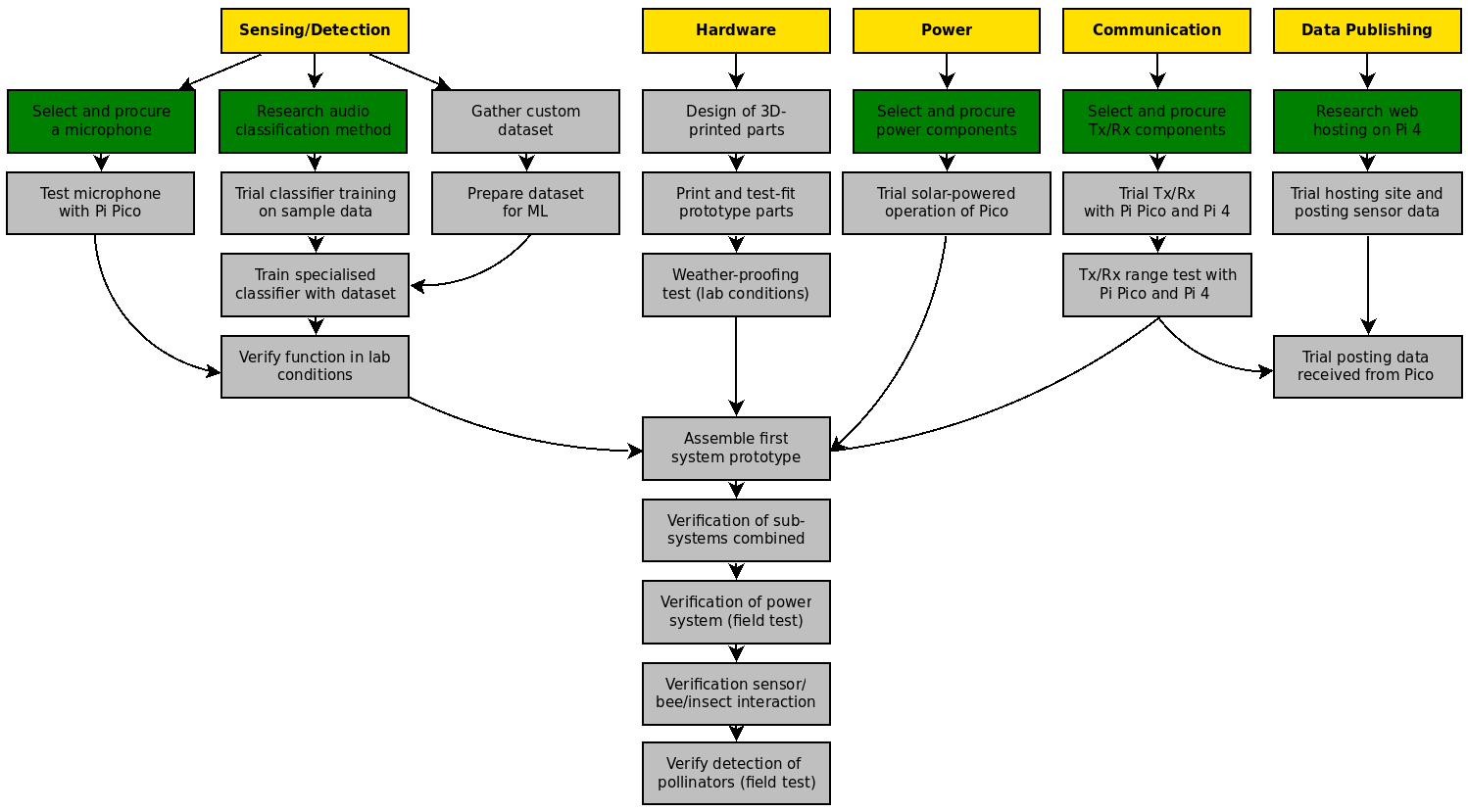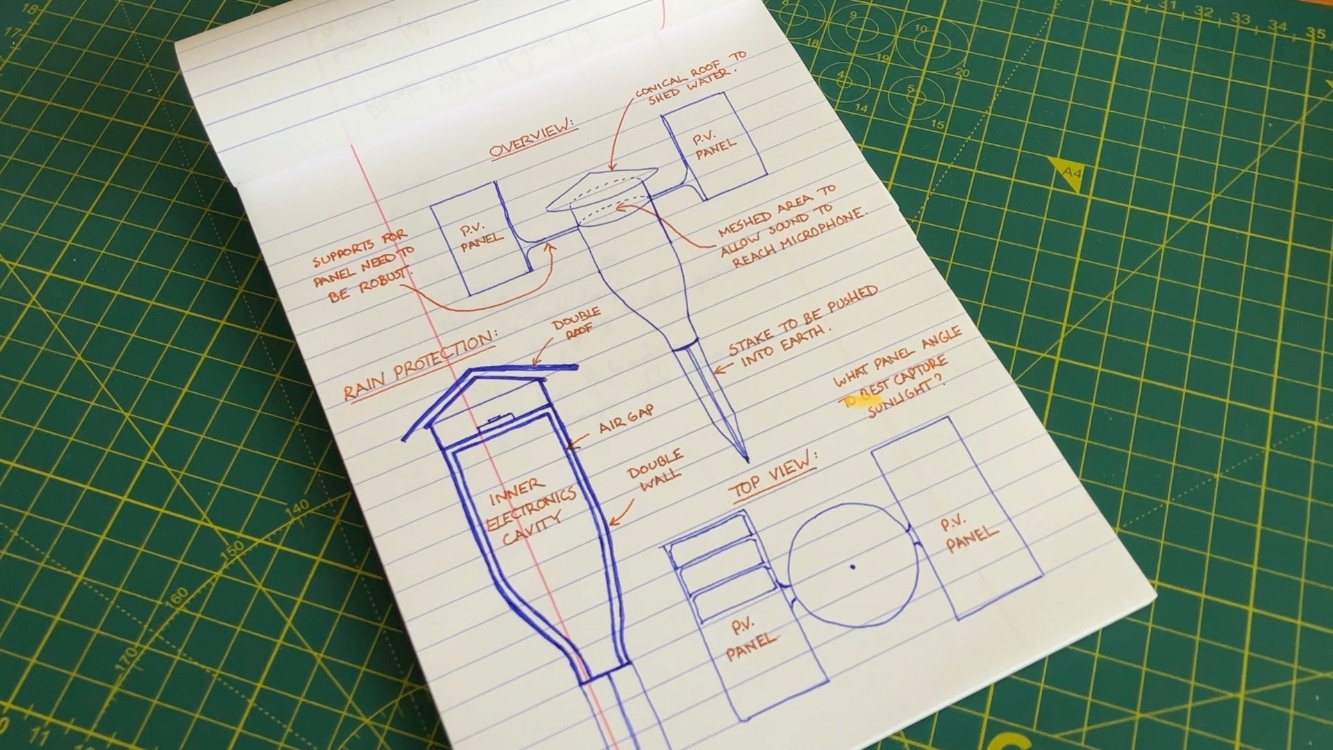Pollinator Pollster (Powered by Pi)
Hello again, it has been a fairly quiet time recently on this project on first appearances, partly because I have been away for a while, but I've still been able to chip away at different aspects of the project and most importantly, get all of the needed components selected and ordered - should be a busy postman over the next few days!
Update Video
Project Plan
Below see an updated project flowchart, with several additional steps coloured green for completed, namely the selection and purchasing of all hardware. In this blog post I will describe my selection of those.

Selection of Transceiver
The sensors (which will be run by Pi Picos) will need to send detection data back to the Pi 4 base station. To do this I need reasonable range (ideally several hundred metres), low power consumption, and most importantly, to comply with UK radio frequency laws. There are several options of transceiver breakout boards which are supported by Raspberry Pi and Pi Pico.
nRF24L01 2.4GHz Transceiver - Common and cost effective, these are often used with Arduino/Pi. However, I rejected this breakout board as the range is very limited, typically used for indoor or very short range applications.
nRF24L01+PA+LNA+SMA 2.4GHz Transceiver - At first look this seemed to be the most promising option, it has much commonality with the basic nRF24L01, but adds transmission and reception amplification and a much better aerial, achieving peak ranges of up to 1800m. HOWEVER, this range is only achievable at a transmission power of 100mW - which is in breach of OFCOM (the UK telecomms regulator) rules. Reading into it, it is possible to specify lower power (and legal) operation when programming with the unit, but it seems as if this transceiver is better supported for Arduino rather than Raspberry Pi, and the Python usage of it is quite limited.
HC-12 433.4-473.0 MHz Transceiver - The HC-12 seems very well supported on Raspberry Pi (see this fantastic guide which was a big help). The frequency range as a whole exceeds the permitted band in the UK, but using only the first 4 channels of the transceiver is within. The maximum power of the unit is also 100mW, but this can be set in the program to a lower level which is under the 10mW threshold to comply with the regulations. At that power level, the guide I linked above suggests that I can expect a range of 180m with the default spring antenna, and this can be increased with a different antenna or the use of a capacitor. So the HC-12 is what I've gone with!
Selection of Power System
As mentioned before, the sensor is going to be solar-powered, as it will be stuck outside far away from available mains electricity. I've really enjoyed down-selecting this and learning about solar power and am excited to get hands-on with the kit when it arrives.
To start with I looked up sunlight data for London, UK. I learned that an average of 1.7 hours a day of sunlight is typical for December, the dimmest month. To design a system around this would result in very large solar panels and very large batteries. Given that the Woodland Trust states that most bees hibernate between autumn and spring, I have chosen to optimise the design for March-September usage, a better compromise of practicality vs utility. March has a typical 3.6 hours of sunlight per day.
Summing up my power requirement (the Pi Pico, plus the HC-12 transceiver in transmit mode for 10 seconds every 5 minutes, and idle otherwise), I need a constant 0.3W for operation. This is 7.18Wh/day. Dividing this by 3.63 hours of sunlight = a minimum panel wattage of 1.98W. Scaling this by 1.5 I get a needed panel wattage of 3W.
To calculate battery capacity, I divided 7.18Wh by (3.7V x 1000) x 1.5 (spare capacity factor) to get ~ 3000mAh.
I will also need a power management board to safely charge the battery and also provide voltage to the system. I chose the Adafruit 'Universal USB / DC / Solar Lithium Ion/Polymer charger - bq24074'. Slightly more expensive than some alternatives perhaps, but backed up by typical Adafruit quality, this board also is very feature-rich with good online support. It thrives on a solar panel input voltage of 6-9V. I therefore have chosen to pair this with a single 3W 6V panel (disregarding a previous idea I had to have a smaller pair of panels, one either side of the sensor).
Selection of Microphone
The sensor does of course need a small microphone in order to hear the pollinating insects! I chose the Adafruit 'PDM MEMS Microphone Breakout' being a very minute microphone breakout board that I believe will be fairly straightforward to interface successfully with the Pi Pico. This is an area of the project that I was able to find less information online, so I will need to experiment with this more myself to see the best way to use it.
Other Things
Mainly I'm happy that I've been able to get everything I need ordered for now, but there have been some other things I've also got done and will discuss more in another post.
- Started mechanical concepting, especially considering how to ensure the sensor body containing the electronics is waterproof.
- Continued to learn how to train the audio classifiers, this is still far from complete, but there's gradual progress!
- Learned how to use Python to prepare audio files for the machine learning, currently using bumblebee sounds scoured from the internet, but I will be able to do this with my own collected dataset soon - every time I see a bee I'm chasing after it with my iPhone voice recorder to get a few more brief clips!
See you next time!



Top Comments